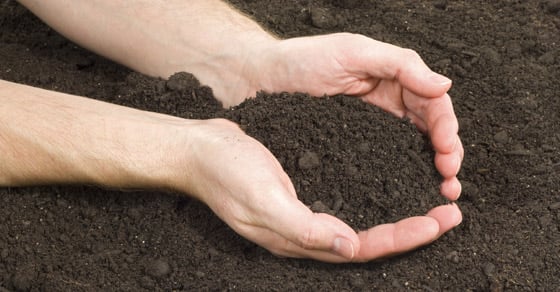Drought is becoming a rising concern across the world as water scarcity, changing climate patterns, and the need to feed a growing population continue to dominate the landscape of pressing global issues. As such, the need for soils to be capable of withstanding drought conditions is becoming increasingly critical.
While a multi-faceted approach will likely be needed, some scientists are looking at biochar as a potential method in improving soil’s ability to cope with drought.
What is Biochar?
Biochar is a carbon-based material created through the pyrolysis of biomass. Various forms of biomass can be processed to produce biochar, with woody biomass and agricultural residues being common sources.
Biochar has been gaining recognition in recent years as a means of restoring soils due to the many benefits it can offer, as is evidenced by ancient Amazonian Terra Preta soils. Reduced leaching, improved soil fertility, and soil acidity moderation are just a few of the benefits the International Biochar Initiative recognizes.
The Impact of Biochar on Drought Resistance
A precursor to activated carbon (an extremely effective adsorbent), biochar is a highly porous material – a characteristic that when combined with its unique chemical makeup, allows it to capture and hold minute particles. This not only allows it to hang on to nutrients, but it also allows it to hold on to moisture and provide a habitat for microorganisms.
The use of biochar in soil has become the topic of many research studies as of late, with studies running the gamut of objectives. Despite increased research around biochar, nearly all studies recognize that more research is needed to fully understand the mechanisms by which biochar works in soils to achieve various goals.
According to one biochar producer, biochar not only improves water retention, but also works with a plant’s root system in order to use water (and nutrients) more efficiently. The company claims that biochar can reduce water needs by nearly half.²
One study conducted on sandy loam soils found biochar to increase water retention in both organic and conventionally managed soils. Not surprisingly, the study attributes the increased water retention to biochar’s porous surface structure.
Another study showed biochar to increase soil water holding capacity by 11%, though the authors note that more research on whether or not this will be able to help balance fluctuations in water availability in a climate with increased periods of drought is needed.¹
Biochar can also impact the microbial populations in soil and may even cause the promotion of beneficial microorganisms that foster growth and resistance to biotic stresses according to one study. Another study that looked at biochar in relation to tropical soils found biochar to significantly increase the ability of both fungal and bacterial populations in soil to resist drought.
Producing Biochar for use as a Soil Amendment
Biomass must go through a series of processing steps in order to transform it into a usable soil amendment.
Drying
Biochar is produced in a rotary kiln – typically of the indirect-fired configuration in order to create the oxygen-limited processing environment. Before biomass is pyrolyzed in a rotary kiln, it is first typically dried in a rotary dryer to reduce the initial moisture content of the material and improve the efficiency of the downstream kiln.
Drying typically occurs at temperatures less than 500ºF.
Pyrolysis
The dried biochar is then fed to the rotary kiln, where it is processed at temperatures around 500 – 800ºF. Between these temperatures, the volatile components are burned off (yielding syn gas) and the carbon is converted to a more stable form.
The source material used to create biochar can be any type of biomass, though it is well acknowledged that different source materials will result in different end product characteristics. Similarly, process conditions can also affect the characteristics of the end product. Combined with variations in soils, environments, and climates, more research is needed around producing a biochar product with the desired characteristics to meet specific applications.
Agglomeration
Once the biomass material has been transformed into a biochar product, it is in the form of a fine powder. While this fine powder can be used directly, it is most often desirable to agglomerate it in order to avoid product lost as dust and difficulties in handling and application.
The agglomeration process is flexible, and can allow other materials such as compost or micronutrients to be mixed into the feedstock as well. Some biochars are difficult to pelletize alone and are often included as part of a blend with something else to assist in enabling successful agglomeration.
Research around the agglomeration of biochar into a premium soil amendment product is ongoing, with methods such as compaction granulation and pelletizing being common approaches.
Conclusion
While more research on the topic is needed, research shows that biochar could be a valuable tool in the drought tolerance effort amidst a changing climate, water scarcity, and an increasing need to produce more food with fewer resources.
FEECO offers a unique testing center where we can test the feasibility of your intended process, and can even aid in biochar process and product development. Whether you need to test biomass drying, pyrolysis, agglomeration, or a continuous process loop utilizing multiple processes, the FEECO Innovation Center can help.
We can then manufacture the custom rotary dryers, kilns, and disc pelletizers to carry out your process on a commercial scale. For more information, contact us today!
SOURCES:
- Karhu, Kristiina, Tuomas Mattila, Irina Bergström, and Kristiina Regina. “Biochar addition to agricultural soil increased CH4 uptake and water holding capacity – Results from a short-term pilot field study.” Agriculture, Ecosystems & Environment 140.1-2 (2011): 309-13. ResearchGate. Web. May 2017.



